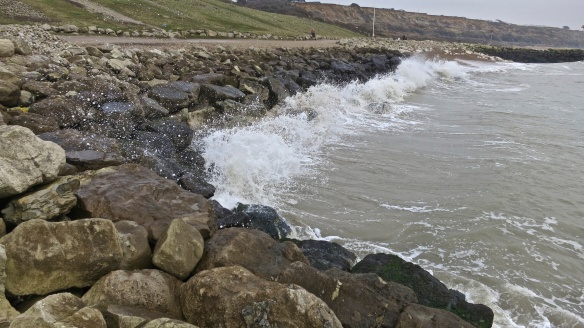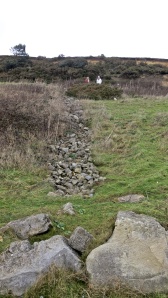On this dull, wet, day we decided we might as well go somewhere that was already damp, so Jackie drove us to Highcliffe for her to do the charity shop round and for me to walk. On the approach to Emery Down, my greying Easy Rider, long locks flying, pedalled vigorously towards us, passing on the other side of the road.
Leaving the car in Wortley Road car park we went our different ways along the High Street. I turned right at the end and walked to the cliff, down to and along the beach to my right, and eventually back along the footpath along the top.

Ever seeking a different view of the Isle of Wight and The Needles, as I peered from above across the choppy seas I found they had been moved. If not by Mike who I was to meet later, perhaps they were just obscured by the mist.


 A few scattered walkers were out contemplating the waves, and one lone dog walker occasionally came into view.
A few scattered walkers were out contemplating the waves, and one lone dog walker occasionally came into view.  Crunching along the shingle watching and listening to the breakers crashing against what I was to learn were the groynes and the revetments, I occasionally ambled the length of these structures jutting out to sea, standing where Sam and Malachi had done on 13th January last year, and peering across the Channel. Planted in a pile of the stones was what I took to be imaginative piece of modern sculpture that may have been a contender for the Turner prize.
Crunching along the shingle watching and listening to the breakers crashing against what I was to learn were the groynes and the revetments, I occasionally ambled the length of these structures jutting out to sea, standing where Sam and Malachi had done on 13th January last year, and peering across the Channel. Planted in a pile of the stones was what I took to be imaginative piece of modern sculpture that may have been a contender for the Turner prize.
 As I progressed along the beach the sound of sliding pebbles receded like the advancing waves slipping back into the sea. They competed unsuccessfully with the chug chug and rattle of a heavy digger in the distance. As I approached, it dumped a huge boulder that I imagine must have come from area of disturbed sand left between similar rocks strung out in a row.
As I progressed along the beach the sound of sliding pebbles receded like the advancing waves slipping back into the sea. They competed unsuccessfully with the chug chug and rattle of a heavy digger in the distance. As I approached, it dumped a huge boulder that I imagine must have come from area of disturbed sand left between similar rocks strung out in a row.
By the time I reached the machine it had been silenced and its operator, standing by the grabbing end wrenched at the clawed structure attached to the crane. The very friendly man was Mike, who was Neptune, the company contracted to maintain the Dorset coast at this point. His firm’s patch extended from Hengistbury Head to Chewton Bunny. More than happy to stop what he was doing and engage in a most informative conversation, Mike was about to ‘do some digging’ for which he needed a different grabber. 

 Seeing him operate the heavy machinery and his wrench gave me some idea as to what he owed the grip of his handshake.
Seeing him operate the heavy machinery and his wrench gave me some idea as to what he owed the grip of his handshake.
It was Mike who told me the terms for the rocks that jut out to sea, the groynes; and the piles along the shingle, the revetments. Groynes offer protection from the seas, and revetments keep the embankments in place. It is Mike’s task to redesign and maintain these defences. In describing this constant activity he called himself a dung beetle, which I thought a lovely image. This hardy individual, ever since playing here as a boy, has learned the nature of the tides, the winds, and the currents and how each effects the coastline. It
It  seems to me a tragedy that the current political and economic climates have already reduced, and are likely to jeopardise the rest of, his operation.
seems to me a tragedy that the current political and economic climates have already reduced, and are likely to jeopardise the rest of, his operation.
On previous visits I have been puzzled by lines of smaller rocks stretching down from the cliff top at regular intervals. These stones cover membranes much, I imagine, like those used to suppress weeds in a garden. Having been put in place by Neptune, they are draining the cliffs. My informant considers this a major difference between Highcliffe and Barton on Sea where there is no drainage and the cliffs are constantly in danger of subsidence.
Our evening sustenance was provided by sausage casserole (recipe), carrots, rich green broccoli, and mashed potato containing chopped chives. Creme caramel was to follow. I finished the Cahors and Jackie drank another glass of the Nobilo.
Recipe links – brilliant idea! x
🙂 X
Thanks Derrick.
And you, for the interest, John